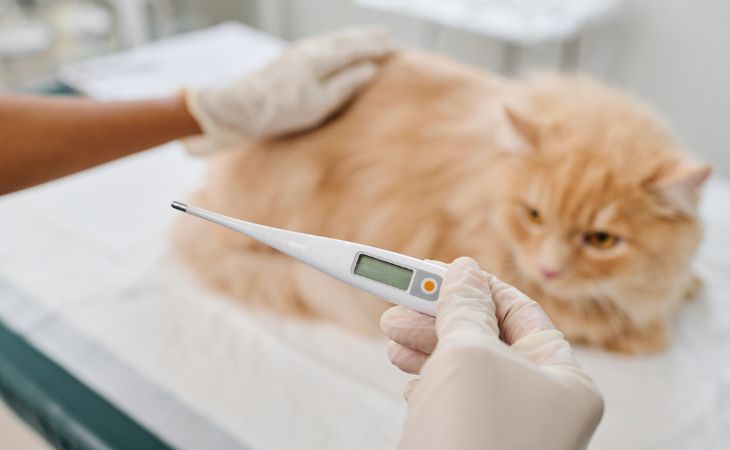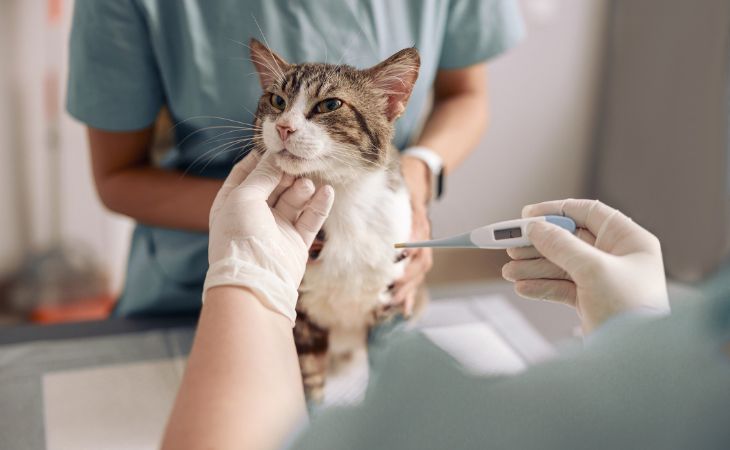A fever, a change in your cat’s behavior, a loss of appetite—these are all reasons why you might want to take your cat’s temperature. However, taking your cat’s temperature can be difficult, especially if your cat is unwilling to let you. To help you take care of your cat’s health, here are some helpful tips from Letsgetpet to take your cat’s temperature.
How do I recognize fever symptoms?
Just like humans, domestic felines can also have a fever. To quickly discern if your cat is not feeling well, you need to be attentive and observant.
Keep an eye on changes in your cat’s behavior
One of the first symptoms of a fever is changes in a cat’s behavior. Naturally, cats are careful animals. When they are sick, they have a tendency to hide so that they can make themselves less vulnerable. If your cat is usually friendly, active, or playful, they might start to put themselves on the side when not feeling well. In general, they will hide under the couch, under the table, under the bed, or in any other area where it is difficult to move them.
Keep an eye on your cat’s appetite
The loss of appetite is also a frequent symptom of illness that you can quickly detect in your cat. They can suddenly stop eating their daily meal or not touch their food at all. It is important to check your cat’s food bowl to see if they really ate. If you notice that they didn’t touch their food, try to encourage them to eat by giving them a more appetizing meal. You can also give them one of their favorite foods and bring their bowl to them yourself. If your cat does not feel well, they will not feel good enough to come out of their hiding place. If this is the case, the ideal thing to do is put down their food bowl in a hidden and safe place. This can motivate them to eat.
Check your cat’s litter
In addition to having a fever, several illnesses can also provoke diarrhea or vomiting. To understand the state of your cat’s health, check their litter. In most cases, they will try to hide it. Try to follow your cat if they spend most of their time outside. Check areas where they like to hang out. It is likely that they dig here to bury their waste.
Check to see if your cat is feeling lethargic
This symptom is difficult to recognize because cats are naturally sleepy and lazy. A useful tip is to take one of your cat’s favorite foods. If they do not follow you like they usually do, they are probably feeling lethargic. In addition, if your cat is sick, they might stay in the same room to sleep instead of follow you around when you move. If this is the case, we recommend consulting a vet, especially if your domestic feline suddenly looks really tired and lazy.
How do I take my cat’s temperature?
If you identified any of these symptoms in your cat, it is important to take their temperature to confirm that they are sick. It isn’t enough to touch their forehead like you do with children. The best way to check their temperature when you are at home is to use a thermometer. To do this, you can take their temperature from their ear or their rectum.
Taking your cat’s temperature from their ear
Taking your cat’s temperature from their ear requires the use of an ear thermometer specially designed for domestic felines. These instruments have an end that is long enough to reach the ear canal of your cat. You can easily find these types of thermometers from a vet clinic or from pet supply stores. This technique is better suited for aggressive cats.
To take the temperature of your cat from their ear, start by holding their body firmly. Place them on the ground or on a flat surface and keep their paws on the surface. Hold their head firmly with your arm so that they cannot move their head away or become aggressive when their temperature is taken. If you are able, ask someone close to you to help keep them in place.
Then, insert the thermometer into your cat’s ear canal and hold it there for a few minutes before removing it. We recommend reading the instructions and following them to know with certitude when the temperature has been taken.
Lastly, clean the thermometer with water and soap, or with 90% alcohol and put it away.
Taking your cat’s temperature from their rectum
This method is much more reliable than the previous one. Like the ear method, the first step is to choose and prepare the thermometer to be used. If you opt for an instrument that contains mercury, shake it before using it. The digital thermometer has the advantage of being able to give a result quickly. If you choose this type of instrument, we recommend using a small disposable bag. This method of taking temperature is more more reliable than the previous one.
To not hurt your cat or stress them, it is important to lubricate the thermometer before inserting it into their rectum. You can use a lubricant that is water-based or simply use petroleum jelly. The use of a lubricant also allows you to limit the risks of irritation and abrasion.
Be patient and delicate with your cat to keep them calm
Once this step is finished, you need to correctly position your cat. For them to not move, hold them under your arm. The head of your cat should be turned towards your back. To avoid getting scratched, make sure that they are positioned on a solid surface such as the floor. To be more precautious, you can also ask a friend for help. To reassure and calm your cat, you can grab their skin by the neck to keep them in place. Many felines associate this with a protective gesture from their mother.
Then, insert the thermometer 2 centimeters into the rectum. Keep the instrument at a 90° angle to insert it into your cat’s rectum straight. If you angle the instrument while inserting it, this can cause your cat discomfort and pain. Keep the thermometer in place for around 2 minutes. If you are using a mercury thermometer, you need to be patient for more time. In general, the majority of digital thermometers make a beeping sound to notify when the operation is finished. During this step, your cat might want to bite you, scratch you, or fight their way out. Be very patient and delicate with them so that they can stay calm. This will prevent you and your cat from getting hurt.
Lastly, read the result, then clean the instrument. To clean it, you can use 90% alcohol or hot water and soap.

How do I interpret the thermometer readings?
Cats that do not have a fever have an internal body temperature between 38 et 39 °C (≈ 100.4 and 102.2°F). However, the temperature of your cat can vary based on their physical activity and the weather conditions. In one day, their temperature can raise during the day and go down at night.
After taking your cat’s temperature, if the thermometer shows a temperature that is below 37 °C (≈ 98.6°F), your cat probably has severe hypothermia. There are several reasons for this: the effects of age or dehydration. If your cat is still very young, this could be fatal.
If the temperature is higher than 39°C (≈ 102.2°F), it can be an infection. In these two cases, contact a vet as soon as possible.

